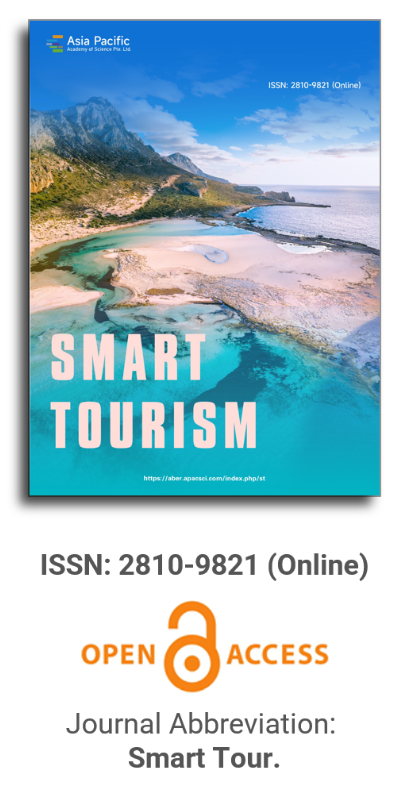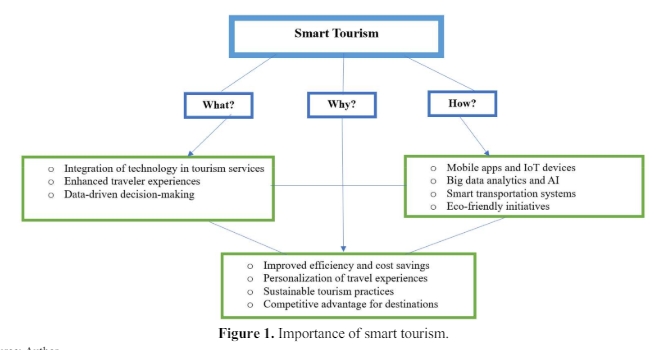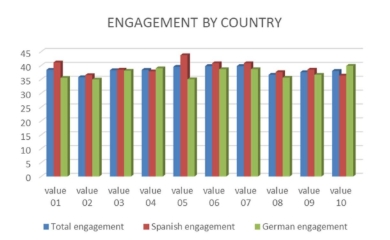


Investigating of social media travel photos on future destination choice: A mixed methodology approach
Vol 5, Issue 2, 2024
Download PDF
Abstract
This study aims to examine the attractiveness of travel photos on social media and understand the relationship between travel photo sharing on social media and destination choice intention. A mixed methodology is used in this study. Twenty-nine semi-structured interviews and thematic analysis were conducted. The attractiveness of key travel photos was categorised as ‘nature & landscape’, ‘way of life’, ‘architecture/buildings’ and ‘people’ and these categories affected the future destination choices of social media viewers. This quantitative study uses data collected from 388 respondents via convenience sampling. Findings showed that the attractiveness of travel photos on social media exerts a significant effect on destination choice intention. In addition, celebrity-generated content mediates the relationship between travel photos and future destination choice intention. Destination marketers can promote places through the four identified travel photo categories using social media channels with celebrity-generated content.
Keywords
References
- Leung D, Law R, van Hoof H, et al. Social Media in Tourism and Hospitality: A Literature Review. Journal of Travel & Tourism Marketing. 2013; 30(1–2): 3–22. doi: 10.1080/10548408.2013.750919.
- Tham A, Croy G, Mair J. Social Media in Destination Choice: Distinctive Electronic Word-of-Mouth Dimensions. Journal of Travel & Tourism Marketing. 2013; 30(1–2): 144–155. doi: 10.1080/10548408.2013.751272.
- Ramirez E, Gau R, Hadjimarcou J, et al. User-generated content as word-of-mouth. Journal of Marketing Theory and Practice. 2018; 26(1–2): 90–98. doi: 10.1080/10696679.2017.1389239.
- Nguyen H, Martin BAS, Kerr G. Effects of Materialism on Brand-Related User-Generated Content and Positive WOM on Social Media. Australasian Marketing Journal. 2021; 31(2): 135–141. doi: 10.1177/18393349211054230.
- Zeng B, Gerritsen R. What do we know about social media in tourism? A review. Tourism Management Perspectives. 2014; 10: 27–36. doi: 10.1016/j.tmp.2014.01.001.
- Li F. Understanding Chinese tourists’ motivations of sharing travel photos in WeChat. Tourism Management Perspectives. 2019; 33.
- Stepchenkova S, Zhan F. Visual destination images of Peru: Comparative content analysis of DMO and user-generated photography. Tourism Management. 2013; 36: 590–601. doi: 10.1016/j.tourman.2012.08.006.
- Roy S. Meaning transfer in celebrity endorsements: an explanation using metaphors. Journal of Marketing Communications. 2016; 24(8): 843–862. doi: 10.1080/13527266.2016.1197294.
- Yılmazdoğan OC, Doğan RŞ, Altıntaş E. The impact of the source credibility of Instagram influencers on travel intention: The mediating role of parasocial interaction. Journal of Vacation Marketing. 2021; 27(3): 299–313. doi: 10.1177/1356766721995973.
- Joinson AN. Looking at, looking up or keeping up with people? In: Proceedings of the SIGCHI Conference on Human Factors in Computing Systems; 2008. doi: 10.1145/1357054.1357213.
- Wang J, Wang S, Xue H, et al. Green image and consumers’ word-of-mouth intention in the green hotel industry: The moderating effect of Millennials. Journal of Cleaner Production. 2018; 181: 426–436. doi: 10.1016/j.jclepro.2018.01.250.
- Savakis AE, Etz SP, & Loui AC. Evaluation of image appeal in consumer photography. In: Human vision and electronic imaging V. SPIE; 2000. Volume 3959. pp. 111–120.
- San Pedro J, Siersdorfer S. Ranking and classifying attractiveness of photos in folksonomies. In: Proceedings of the 18th international conference on World wide web; 2009. doi: 10.1145/1526709.1526813.
- MacKay KJ, Couldwell CM. Using Visitor-Employed Photography to Investigate Destination Image. Journal of Travel Research. 2004; 42(4): 390–396. doi: 10.1177/0047287504263035.
- Pan X, Rasouli S, Timmermans H. Investigating tourist destination choice: Effect of destination image from social network members. Tourism Management. 2021; 83: 104217. doi: 10.1016/j.tourman.2020.104217.
- Crompton J. Structure of vacation destination choice sets. Annals of Tourism Research. 1992; 19(3): 420–434. doi: 10.1016/0160-7383(92)90128-C.
- Decrop A, Snelders D. A grounded typology of vacation decision-making. Tourism Management. 2005; 26(2): 121–132. doi: 10.1016/j.tourman.2003.11.011.
- Keshavarzian P, Wu C. A qualitative research on travellers’ destination choice behavior. International Journal of Tourism Research. 2017; 19(5): 546–556. doi: 10.1002/jtr.2128.
- Mohsin A, Ryan C. Determinants of Destination Choice: The Role of Socio-demographic Variables. Tourism Recreation Research. 2004; 29(3): 27–33. doi: 10.1080/02508281.2004.11081454.
- Karl M, Reintinger C, Schmude J. Reject or select: Mapping destination choice. Annals of Tourism Research. 2015; 54: 48–64. doi: 10.1016/j.annals.2015.06.003.
- Nyman E, Westin K, Carson D. Tourism destination choice sets for families with wheelchair-bound children. Tourism Recreation Research. 2017; 43(1): 26–38. doi: 10.1080/02508281.2017.1362172.
- Gartner WC. Image formation process. Journal of Travel & Tourism Marketing. 1993; 2(2): 191–216. doi: 10.1300/J073v02n02_12.
- Tasci ADA, Kozak M. Destination brands vs destination images: Do we know what we mean? Journal of Vacation Marketing. 2006; 12(4): 299–317. doi: 10.1177/1356766706067603.
- Croy WG. Planning for Film Tourism: Active Destination Image Management. Tourism and Hospitality Planning & Development. 2010; 7(1): 21–30. doi: 10.1080/14790530903522598.
- Friedman HH, & Friedman L. Endorser effectiveness by product type. Journal of Advertising Research. 1979; 19(5): 63–71.
- McCracken G. Who is the Celebrity Endorser? Cultural Foundations of the Endorsement Process. Journal of Consumer Research. 1989; 16(3): 310. doi: 10.1086/209217.
- Seno D, Lukas BA. The equity effect of product endorsement by celebrities. European Journal of Marketing. 2007; 41(1/2): 121–134. doi: 10.1108/03090560710718148.
- Escalas JE, Bettman JR. Managing Brand Meaning through Celebrity Endorsement. Review of Marketing Research. 2015: 29–52. doi: 10.1108/s1548-643520150000012002.
- Djafarova E, Trofimenko O. ‘Instafamous’—credibility and self-presentation of micro-celebrities on social media. Information, Communication & Society. 2018; 22(10): 1432–1446. doi: 10.1080/1369118x.2018.1438491.
- Geng R, Wang S, Chen X, et al. Content marketing in e-commerce platforms in the internet celebrity economy. Industrial Management & Data Systems. 2020; 120(3): 464–485. doi: 10.1108/imds-05-2019-0270.
- Patel P, & Basil M. The effects of celebrity attractiveness and identification on advertising interest. In: Academy of Marketing Science Annual Conference. Springer, Cham; 2017. pp. 579–589.
- Wright SA. Reinvestigating the Endorser by Product Matchup Hypothesis in Advertising. Journal of Advertising. 2015; 45(1): 26–32. doi: 10.1080/00913367.2015.1077360.
- Gretzel U, & Sigala M. Advances in Social Media for Travel, Tourism and Hospitality. Oxon: Routledge; 2017.
- Langlois JH, Kalakanis L, Rubenstein AJ, et al. Maxims or myths of beauty? A meta-analytic and theoretical review. Psychological Bulletin. 2000; 126(3): 390–423. doi: 10.1037/0033-2909.126.3.390.
- Zebrowitz LA, Hall JA, Murphy NA, et al. Looking Smart and Looking Good: Facial Cues to Intelligence and their Origins. Personality and Social Psychology Bulletin. 2002; 28(2): 238–249. doi: 10.1177/0146167202282009.
- Zebrowitz LA, & Rhodes G. Sensitivity to “bad genes” and the anomalous face overgeneralization effect: Cue validity, cue utilization, and accuracy in judging intelligence and health. Journal of nonverbal behavior. 2004; 28(3): 167–185. doi: 10.1023/B:JONB.0000039648.30935.1b.
- Gao P, Wang X, Chen H, et al. What is beautiful is not always good: influence of machine learning-derived photo attractiveness on intention to initiate social interactions in mobile dating applications. Connection Science. 2020; 33(2): 321–340. doi: 10.1080/09540091.2020.1814204.
- Zhang H, Fu X, Cai LA, et al. Destination image and tourist loyalty: A meta-analysis. Tourism Management. 2014; 40: 213–223. doi: 10.1016/j.tourman.2013.06.006.
- Chew EYT, Jahari SA. Destination image as a mediator between perceived risks and revisit intention: A case of post-disaster Japan. Tourism Management. 2014; 40: 382–393. doi: 10.1016/j.tourman.2013.07.008.
- Hallmann K, Zehrer A, Müller S. Perceived Destination Image. Journal of Travel Research. 2013; 54(1): 94–106. doi: 10.1177/0047287513513161.
- Kanwel S, Lingqiang Z, Asif M, et al. The Influence of Destination Image on Tourist Loyalty and Intention to Visit: Testing a Multiple Mediation Approach. Sustainability. 2019; 11(22): 6401. doi: 10.3390/su11226401.
- Knoll J, Matthes J. The effectiveness of celebrity endorsements: a meta-analysis. Journal of the Academy of Marketing Science. 2016; 45(1): 55–75. doi: 10.1007/s11747-016-0503-8.
- Statista. Social network penetration in China from 2015 to 2022. 2017. Available online: https://www.statista.com/statistics/277622/user-penetration-rate-of-social-networks-in-china/ (accessed on 5 June 2024).
- Boyatzis RE. Transforming qualitative information: Thematic analysis and code development. Sage; 1998.
- Braun V, Clarke V. Using thematic analysis in psychology. Qualitative Research in Psychology. 2006; 3(2): 77–101. doi: 10.1191/1478088706qp063oa.
- UNWTO. Available online: https://www.unwto.org/ (accessed on 5 June 2024).
- Kim H, Stepchenkova S. Effect of tourist photographs on attitudes towards destination: Manifest and latent content. Tourism Management. 2015; 49: 29–41. doi: 10.1016/j.tourman.2015.02.004.
- Filieri R, Lin Z, Pino G, et al. The role of visual cues in eWOM on consumers’ behavioral intention and decisions. Journal of Business Research. 2021; 135: 663–675. doi: 10.1016/j.jbusres.2021.06.055.
- Pham NT, Tučková Z, Chiappetta Jabbour CJ. Greening the hospitality industry: How do green human resource management practices influence organizational citizenship behavior in hotels? A mixed-methods study. Tourism Management. 2019; 72: 386–399. doi: 10.1016/j.tourman.2018.12.008.
- Chi CGQ, Qu H. Examining the structural relationships of destination image, tourist satisfaction and destination loyalty: An integrated approach. Tourism Management. 2008; 29(4): 624–636. doi: 10.1016/j.tourman.2007.06.007.
- Bentler PM, & Wu EJ. EQS 6.1 for Windows. Encino, CA: Multivariate Software INC. 2005.
- Byrne BM. Structural Equation Modeling with Mplus. Routledge; 2013. doi: 10.4324/9780203807644.
- Hartmann T, Goldhoorn C. Horton and Wohl Revisited: Exploring Viewers’ Experience of Parasocial Interaction. Journal of Communication. 2011; 61(6): 1104–1121. doi: 10.1111/j.1460-2466.2011.01595.x.
Supporting Agencies
Copyright (c) 2024 Chi Fai SiTou, Ja Young (Jacey) Choe, Amy Siu Ian So, Rob Law
License URL: https://creativecommons.org/licenses/by/4.0/

This site is licensed under a Creative Commons Attribution 4.0 International License (CC BY 4.0).

Prof. Hung-Che Wu
Nanfang College, Guangzhou
China
Indexing & Archiving
Asia Pacific Academy of Science Pte. Ltd. (APACSCI) specializes in international journal publishing. APACSCI adopts the open access publishing model and provides an important communication bridge for academic groups whose interest fields include engineering, technology, medicine, computer, mathematics, agriculture and forestry, and environment.



.jpg)
.jpg)

.jpg)

